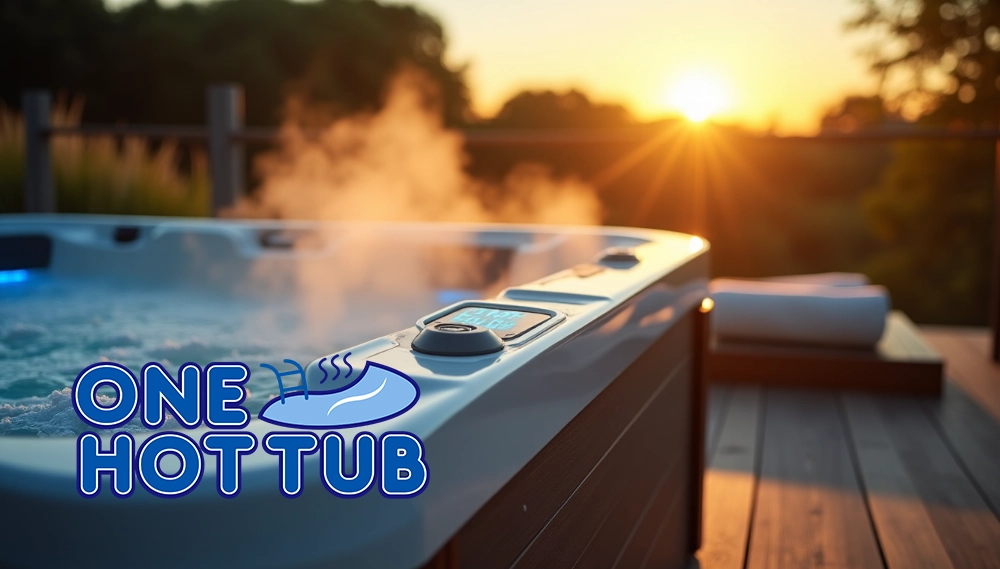Table of Contents - Will a Hot Tub Help Sore Muscles? | Benefits of Soaking for Recovery
This blog post may contain affiliate links. As an Amazon Associate I earn from qualifying purchases.
Will a Hot Tub Help Sore Muscles? | Benefits of Soaking for Recovery

Is Hot Tub Good for Sore Muscles? Science Says Yes (2025 Guide)
Feeling like your muscles are screaming after that workout? Wondering if your hot tub could be the hero your aching body needs? Good news! Science has some pretty exciting answers about those bubbling waters and your sore muscles.
Let’s talk facts! Research really loves hot tub therapy for muscle recovery. Picture this – a 2018 study found men who enjoyed hot water soaking sessions had lower insulin levels and decreased blood glucose concentrations. Pretty neat, right? Even better, another study from 2016 showed people burned roughly the same calories during a one-hour hot bath as they would during a 30-minute walk! Your hot tub helps those sore muscles by boosting circulation, sending oxygen and nutrients exactly where you need them while flushing away all that nasty metabolic waste.
The magic doesn’t stop at physical relief, though! Soaking for just 10 minutes can seriously lower your stress, tension, and anxiety levels – that’s not just feeling good, that’s science from a 2018 study! Your time in the hot tub actually increases somatotropin (a growth hormone that helps cells regenerate) while dropping cortisol (your body’s main stress hormone). Talk about a win-win!
Ready to discover how your evening soak could become your best recovery tool? We’ve gathered the most impressive scientific evidence about hot tubs and muscle recovery. This guide will show you exactly why that relaxing dip works wonders for your aching body and how to get the absolute most out of every bubble!
7 Science-Backed Benefits of Hot Tubs for Sore Muscles
Wondering if your hot tub is actually helping those achy muscles? Well, science is giving us a big thumbs up! Athletes and fitness buffs have been onto something all along—hot tubs really do work wonders for muscle recovery. Let’s dive into the seven amazing benefits that make your relaxing soak a powerful recovery tool!
1. Muscle relaxation and tension relief
Ever notice how your muscles just seem to melt when you sink into warm water? That’s no accident! The moment you slip into your hot tub, the heat starts relaxing your muscle fibers by calming down muscle spindle activity. This natural process helps ease tension and those annoying muscle spasms that show up after a tough workout. Think of heat therapy as a special key that “unlocks” your tight muscles, fighting the stiffness that makes you sore and uncomfortable.
2. Improved blood circulation
Your hot tub session triggers something pretty cool in your body—vasodilation. This fancy term just means your blood vessels widen when you soak in warm water. What’s the benefit? This improved blood flow delivers oxygen and nutrients right to your tired muscles while whisking away all that metabolic waste. Studies show heat exposure significantly boosts circulation, helping you recover faster with less muscle fatigue.
3. Reduction in lactic acid build-up
Know that burning sensation after a hard workout? That’s often lactic acid saying hello! Hot tub therapy has been clinically proven to help with “lactate reduction”—science-speak for clearing out lactic acid from your muscles. Even quick dips have shown promising results for recovery times, performance levels, and athletic stamina. Your muscles will thank you!
4. Joint stress relief and mobility support
Hot tubs offer amazing joint benefits thanks to buoyancy. Did you know your body becomes about 80-90% weightless in water? This significantly reduces pressure on your joints. That weightlessness gives you a break from gravity’s constant pull on your joints. The magic combination of buoyancy and warmth improves your flexibility and range of motion, boosting overall joint health.
5. Inflammation reduction
Got muscle inflammation? Take a soak! Research shows hot tub therapy can lower inflammation in muscles and joints, speeding up healing after exercise. While some inflammation naturally follows workouts, too much leads to pain. Hot water soaking helps fight Delayed Onset Muscle Soreness (DOMS) by increasing oxyhemoglobin levels and improving how oxygen reaches your tissues.
6. Enhanced sleep quality
Sweet dreams are made of… hot tubs? Looks like it! Studies consistently show hot tub therapy improves sleep quality—a crucial piece of the muscle recovery puzzle. Research has found that hydrotherapy affects hormones like histamine and serotonin that regulate body temperature, leading to better sleep. The cool-down after your hot soak actually signals your body it’s bedtime, promoting deeper, more restorative rest.
7. Mental relaxation and stress reduction
Your mind needs recovery too! The mental perks of hot tub therapy go hand-in-hand with physical benefits. Soaking in warm water triggers the release of endorphins—your body’s natural feel-good chemicals. Studies confirm that hot tubs significantly lower stress levels through the combined magic of warm water and those massaging jets. This stress reduction lowers cortisol (your stress hormone), contributing to better overall recovery.
These seven science-backed benefits explain why hot tub therapy has become a go-to recovery method for so many. Far from being just a luxury splurge, your hot tub offers real therapeutic value whether you’re battling muscle soreness or simply looking to bounce back faster!
How Hot Tub Therapy Works for Muscle Recovery
Ever wondered what actually happens to your sore muscles during a hot tub soak? Let’s peek behind the curtain at the science that makes hot tubs so effective for muscle recovery. It’s not just about feeling good—your body undergoes several fascinating changes that create the perfect healing environment.
The role of heat and hydrotherapy
The moment you sink into that warm water, magic starts happening! Your blood vessels dilate, dramatically boosting circulation to tired muscles and tissues. This improved blood flow works like a delivery service—bringing oxygen and nutrients to hungry muscles while whisking away metabolic waste products like lactic acid.
Science shows that when your muscles heat up, they trigger a cascade of amazing events that:
• Replenish energy stores faster
• Enhance vascular function
• Reduce that “can’t-walk-down-stairs” soreness
Studies reveal that targeted heat therapy speeds up recovery of muscle function after fatiguing exercise. At the cellular level, heat therapy fights post-workout damage by raising tissue temperature and increasing wall-shear stress, kickstarting important cellular processes. No wonder your muscles feel so much better after a good soak!
How jets stimulate muscle groups
Those pulsating jets aren’t just for fun! They provide mechanical stimulation that works differently than heat alone. The massaging action helps break up those tight knots in muscle tissue while promoting better circulation—potentially speeding up your recovery time.
Want to target specific sore spots? The jets allow you to customize your recovery session by focusing on particular muscle groups. That painful shoulder from yesterday’s workout? Direct a jet right at it!
The dreamy combo of warm water and massaging jets triggers the release of feel-good chemicals throughout your body. This mechanical stimulation loosens tight muscles and increases flexibility far better than just passive heating alone.
Buoyancy and reduced gravitational pressure
Did you know your body becomes about 80-90% weightless in water? This floating sensation significantly reduces gravity’s constant pull on your joints and muscles.
This weightlessness creates a pressure-free environment where your joints can take a much-needed break and your muscles can fully relax. Meanwhile, the water’s gentle pressure acts like a soft compression bandage, helping flush out excess fluid and inflammatory substances from sore tissues.
This buoyancy benefit makes hot tubs particularly awesome for folks with joint pain or anyone recovering from high-impact workouts that put stress on weight-bearing joints. Your body gets to heal while feeling practically weightless!
Hormonal responses: endorphins and cortisol
Your hot tub session triggers a chemical party in your body! Soaking releases endorphins—your body’s natural mood boosters and pain fighters. These feel-good chemicals create that blissful sensation while naturally dulling pain signals.
Meanwhile, studies show hot water immersion can lower cortisol—your primary stress hormone. This stress reduction is crucial since ongoing stress can slow recovery and make muscle tension worse.
Research has found that hot tub therapy can boost levels of growth hormone and testosterone—both key players in muscle repair and growth. Heat exposure activates genes involved in muscle growth and increases heat shock proteins, which play a starring role in muscle regeneration.
So, do hot tubs actually help sore muscles? Science says absolutely YES! Multiple complementary mechanisms work together to create the perfect recovery environment for your aching body.
When and How to Use a Hot Tub for Best Results
Want to turn your hot tub from a simple relaxation spot into a muscle-healing powerhouse? It’s all about the timing, temperature, and technique! Let’s dive into how to make every soak count for your recovery.
Ideal timing after workouts
Did you know there’s actually a perfect moment to hop in your hot tub after exercise? For regular workouts, just wait until your heart rate returns to normal and your body cools a bit—usually about 15-30 minutes after you finish. This simple pause prevents overheating and keeps you from getting too dehydrated.
But here’s a surprise for you gym warriors! After those super intense sessions that leave your muscles screaming, patience is your friend. Research points to waiting between 24 and 48 hours before taking that healing soak. Why? This smart delay lets the initial inflammation calm down, creating the perfect conditions for hot water to work its magic on your damaged tissues.
Pre-workout vs post-workout soaks
Pre-workout benefits:
- A quick 10-minute dip loosens up tight muscles before you start sweating
- Gets blood flowing to your limbs right when they need it
- Makes your stretching routine way more effective (especially on those chilly mornings!)
Post-workout advantages:
- Helps your hard-working muscles bounce back after they’ve cooled down
- Boosts circulation to flush away all that workout waste
- Treats your stronger muscles to deeper relaxation as a reward
The golden rule? Never jump straight from an intense workout into hot water! This mistake can actually make inflammation worse and leave you dehydrated. Not what we’re going for!
Recommended soak duration and temperature
Finding your hot tub sweet spot makes all the difference:
| Factor | Recommendation | Reason |
|---|---|---|
| Temperature | 100-104°F (38-40°C) | Perfect for blood vessel dilation without health risks |
| Duration | 15-20 minutes | Just right for benefits without overheating |
| Hydration | Before and after | Keeps you hydrated during your therapy |
Be careful not to overdo it! Temperatures above 106°F might give you a not-so-fun experience with nausea or worse, though most people find 100-102°F feels just right and works perfectly.
Stretching exercises in the hot tub
Your hot tub creates the perfect stretching studio! The warm water naturally boosts your flexibility and range of motion. Soak for about 10 minutes first to warm up those muscles, then try these simple moves:
Shoulder rolls and stretches: Roll those shoulders gently forward then backward. Or reach one arm across your body and use your other hand to gently press that elbow toward your chest.
Torso rotations: Put one hand on the side of your tub and the other on your opposite knee, then gently twist toward the hand holding the edge. Feel that spine loosen up!
Quadriceps stretch: Stand with one hand against the wall for balance, bend one knee to bring your heel toward your bottom, and grab your ankle to feel that lovely stretch along your thigh.
Calf and hamstring stretches: Extend one leg in the water, flex your foot until you feel your calf stretching, then lean forward from your hips to give those hamstrings some love.
These gentle movements take your recovery to the next level by stretching out muscles that tightened up during exercise. The result? Less soreness and better mobility for tomorrow’s activities!
Risks and Who Should Avoid Hot Tubs
Hot tubs are amazing for sore muscles, but they’re not everyone’s friend! Let’s dive into who should think twice before taking the plunge and how to keep your soak safe and beneficial.
Heat sensitivity and dehydration
Did you know your body loses significant fluid while soaking? Even when you don’t feel sweaty, that warm water is causing perspiration and raising your heart rate. This sneaky dehydration can lead to:
- Pounding headaches
- Sudden nausea
- Dizzy spells
- Fainting episodes
Seniors, kiddos, and folks taking diuretics face even higher risks! The fix is simple though – drink plenty of water before and after your soak, and keep sessions to a cozy 15-20 minutes max.
Heart conditions and blood pressure concerns
Got heart issues? Tread carefully with hot tubs. When you sink into that toasty water, your blood vessels dilate and blood pressure drops, while your ticker speeds up to compensate. For hearts already working overtime, this can be too much to handle.
Check with your doctor first if you have:
- Unstable angina
- Poorly controlled high blood pressure
- Chronic heart failure
- Heart rhythm problems
- Valve issues
If you’re taking beta-blockers or other heart meds, the plot thickens! These medications can mess with your body’s temperature regulation, making hot tubbing even trickier.
Skin infections and open wounds
Hot tubs can be bacteria playgrounds! Pseudomonas aeruginosa loves warm, bubbly water and causes the dreaded “hot tub rash” (folliculitis). This itchy, bumpy red mess typically shows up days after using a poorly maintained tub and loves hiding under swimsuit areas.
Stay out of the hot tub if you have:
- Cuts or open wounds
- Active skin infections
- A weakened immune system
Pregnancy and other medical conditions
Expecting moms should skip the hot tub altogether, especially during those crucial first three months. The elevated body temperature raises risks for birth defects and miscarriage – definitely not worth it!
Other conditions that don’t play nice with hot tubs include:
- Diabetes
- Multiple sclerosis
- Parkinson’s disease
- Breathing problems
- Cystic fibrosis
No matter how tempting that bubbly relief sounds for your aching muscles, safety comes first! When in doubt, a quick chat with your healthcare provider will let you know if hot tubbing is right for your specific situation.
FAQs
Q1. How long should I soak in a hot tub for muscle recovery?
For optimal muscle recovery, aim to soak in a hot tub for 15-20 minutes at a temperature between 100-104°F (38-40°C). This duration is sufficient to reap the benefits without risking overheating or dehydration.
Q2. Is it better to use a hot tub before or after a workout?
Both pre and post-workout soaks have benefits. A quick 10-minute pre-workout soak can loosen muscles and prepare them for activity. Post-workout, wait 15-30 minutes after exercise to allow your body to cool down before entering the hot tub for recovery benefits.
Q3. Can hot tub use help reduce lactic acid buildup in muscles?
Yes, hot tub therapy can help reduce lactic acid buildup in muscles. The warm water increases blood circulation, which aids in flushing out lactic acid and other metabolic waste products from tired muscles, potentially speeding up recovery.
Q4. Are there any risks associated with using a hot tub for muscle recovery?
While hot tubs are generally beneficial, there are some risks to be aware of. These include dehydration, overheating, and potential issues for people with certain health conditions like heart problems or pregnancy. It’s always best to consult with a healthcare provider if you have any concerns.
Q5. How does hot tub therapy compare to ice baths for muscle recovery?
Hot tubs and ice baths work through different mechanisms. Hot tubs increase blood flow and relax muscles, while ice baths reduce inflammation and numb pain. The choice between the two often depends on the timing and type of recovery needed. Some athletes even use a combination of both for optimal results.



